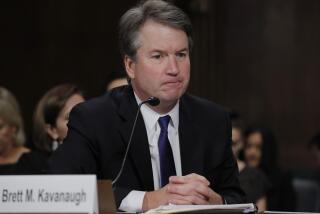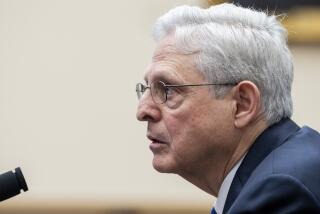Congressional Hearings Conducted Far Differently Than Court Trials : Procedures: Senators often fall back on familiar rules. But guidelines for handling evidence and witnesses are not the same.
- Share via
WASHINGTON — “This is not a court of law,” Chairman Joseph R. Biden Jr. (D-Del.) declared repeatedly as the Senate Judiciary Committee maneuvered through its questioning of Judge Clarence Thomas and Prof. Anita Faye Hill, who has accused him of sexual harassment.
And the world of the congressional hearing is indeed far different from the courtroom.
Here, no fixed rules of procedure or evidence govern the presentations of witnesses or the questions posed by their interrogators. No neutral magistrate stares down from a high bench to separate the combatants and maintain decorum.
But this time the judges, members of the United States Senate, stood on trial as much as the witnesses who appeared before them, particularly in the words of the nominee, who accused the Senate of persecuting him in “a high-tech lynching.”
Inevitably, the senators spent much of the day wrangling over what procedures they were supposed to be following. And as they did, twin ghosts hung over their proceedings--that of Sen. Joseph R. McCarthy, whose long reign as a Red hunter was finally ended by his reckless questioning of committee witnesses, and that of the members of the Iran-Contra investigatory committees, wrapped around the fingers of Lt. Col. Oliver L. North and his counsel, Brendan V. Sullivan Jr.
So, the senators picked their way along, seeking to ask questions without seeming either brutal on the one hand, or ineffective on the other. And slowly, as the day wore on, the members of the committee, most of them experienced lawyers, increasingly fell back on trial rules and procedures--the only model they have--to guide their steps.
Trials, as noted criminal defense lawyer and law professor Anthony Amsterdam has long told his students, in a sense are designed to be conducted in an “artificial world” in which rigidly drawn rules channel all action and discussion toward the resolution of a carefully framed question--can the prosecution prove that the defendant’s conduct violated a specific statute.
“A trial really is not designed to resolve the ultimate facts of the truth,” said Stanford University law professor Barbara A. Babcock. Instead, trials are designed to test “whether the government, or in civil cases the plaintiff, can prove a case.”
And that fundamental factor, what lawyers refer to as the “burden of proof, tilts the playing field,” said Georgetown University criminal law professor Paul F. Rothstein. As a society, “we’ve made the judgment that we’d rather let several guilty people go free than run the risk of putting an innocent person in jail.”
Here, by contrast, the Senate has not resolved the question of where to draw the balance between protecting an innocent person’s reputation and putting a potentially guilty person on the Supreme Court. Thomas’ supporters insist that he should be confirmed unless Hill can prove her charges are true. At the same time, however, they also insisted that Thomas be given the chance to speak first and last--the position reserved in trials for the party that must prove its case.
And at the same time, under the bright lights and the camera’s unforgiving eye, a Senate committee cannot keep the real world, its disagreements and its politics, at a distance. Irresistibly, they intrude.
The intrusions began almost immediately. As Thomas ended his dramatic opening statement, Biden announced that senators on the committee would be allowed to ask him questions but that they would not yet be allowed to ask him about the statements Hill had made to the FBI. GOP Sen. Orrin G. Hatch of Utah, one of Thomas’ chief defenders on the panel, exploded.
“I have a lot of sympathy for Prof. Hill, too,” Hatch said. But “I am not going to sit here and tolerate her attorneys telling you, or me, or anybody else . . . that that statement can’t be used, especially in this proceeding.”
As Biden called a brief recess, the committee seemed to be floundering in confusion. “It would have been very unfair for her story to have come out through the mouths of cross-examiners, for them to say to him, ‘now Prof. Hill says you did this, you didn’t really, did you,’ ” Babcock said.
No sooner was that issue resolved than another appeared as Sen. Arlen Specter (R-Pa.), sought to challenge Hill’s credibility by comparing her current testimony with her previous statements, a standard courtroom approach.
Unlike the procedure in a court, however, Specter was not reading from a transcript of Hill’s earlier statements but from second-hand accounts of what Hill had said--newspaper stories and the report prepared by the FBI agents who interviewed her--what lawyers refer to as “hearsay.”
Although Specter implied that the FBI statements represented Hill’s own words, FBI reports of interviews--”302s,” as agents refer to them--are actually summaries that agents prepare after the fact from notes.
Specter’s ability to read from such documents, first the FBI reports, and then affidavits submitted by other potential witnesses, illustrated “one of the biggest differences between this proceeding and a trial--the right to confront witnesses,” said Washington attorney Abbey David Lowell. In court, hearsay is generally forbidden.
The departures from the way a trial works brought cries of dismay from some observers. “I don’t feel confident they’ll get to the truth of the issue. This process of doing it in public assures you never do,” said Michael F. Barrett, a former congressional committee staff member.
Others, however, were more sanguine. “It’s rough but a trial procedure in the most skilled hands is a rough thing, too,” Babcock said. “For all the bumbling and the crudeness of it, I think the truth is coming out.”
More to Read
Get the L.A. Times Politics newsletter
Deeply reported insights into legislation, politics and policy from Sacramento, Washington and beyond. In your inbox twice per week.
You may occasionally receive promotional content from the Los Angeles Times.











